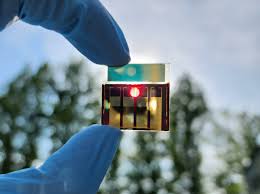Semi-transparent Perovskite Solar Cell:

The IIT Bombay researchers have developed a semi-transparent perovskite solar cell (PSC).
- It is layered over a traditional silicon-based solar cell, forming a 4-terminal (4T) tandem structure.
- The bottom sub-cell uses well-established silicon technology, while the top sub-cell features an indigenously developed halide perovskite semiconductor, enabling high light absorption and efficient energy conversion.
- This helps in power conversion efficiency of approximately 30 per cent compared with around 20 per cent now.
- Halide perovskite is among the most efficient light-absorbing materials known today.
- Apart from being highly efficient in converting light into electricity, it is affordable as electronic grade perovskite semiconductors can be produced locally with available chemical resources.
- Perovskite Solar Cells are a type of photovoltaic (PV) technology that uses crystal structures called perovskites for converting sunlight into electricity.
- These crystals share the structure of the mineral calcium titanium oxide (CaTiO₃)and can be engineered to possess a wide range of optical, electrical, and semiconducting properties.
- The general chemical formula of a perovskite compound is ABX₃, where ‘A’ and ‘B’ are cations, and ‘X’ is an anion.
- They offer high power conversion efficiencies at a lower cost than traditional silicon-based PVs, but they suffer from shorter lifespan and stability issues.




